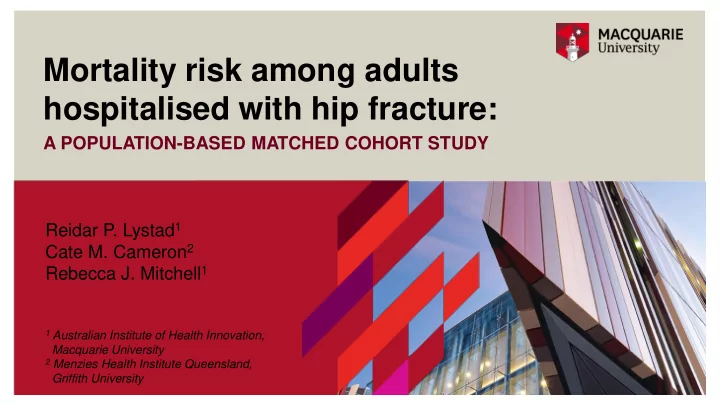

Mortality risk among adults hospitalised with hip fracture: A POPULATION-BASED MATCHED COHORT STUDY Reidar P. Lystad 1 Cate M. Cameron 2 Rebecca J. Mitchell 1 1 Australian Institute of Health Innovation, Macquarie University 2 Menzies Health Institute Queensland, Griffith University
Background • Ageing population Hip fracture is a major public health problem • Hip fracture is a very common cause of death in older people • Many factors have been associated with a higher risk of mortality, e.g. • Sex (males) • Age (older age groups) • Socioeconomic status (lower) • Comorbid or pre-existing health conditions (e.g. CVD, diabetes, mental health) Commonwealth of Australia, 2010
Aim To quantify and describe mortality attributable to hip fracture during the 12 months following a hip fracture-related hospitalisation, among individuals aged ≥65 years in Australia 3
Methods STUDY POPULATION & DATA SOURCES • Population-based matched cohort study using linked emergency department presentation, hospital admission, and mortality records • Hip fracture cohort: • Individuals aged ≥65 years • Hospitalised with hip fracture in 2009 • NSW, QLD, SA, TAS • Comparison cohort randomly selected from the electoral roll, matched 1:1 on age, sex, and residential postcode 4
Methods 12-month Selection 12-month look-back period follow-up period period 2008 2009 2010 Comorbid conditions Mortality Mental health diagnoses Alcohol misuse and dependence Cumulative hospital length of stay 5
Methods OUTCOME MEASURES 12-month survival Kaplan-Meier plot with log-rank test Unadjusted and adjusted Cox proportional hazard regression mortality rate ratios 𝑩𝑺% = 𝟐𝟏𝟏 × 𝒃𝒆𝒌 𝑵𝑺𝑺 − 𝟐 Attributable risk percentage 𝒃𝒆𝒌 𝑵𝑺𝑺 Mortality rate by month Time series plot post injury 6
Results COHORT CHARACTERISTICS Hip fracture cohort Non-injured cohort Characteristic (n=9,748) (n=9,748) Australian state n % n % New South Wales 5,309 56.0 5,309 56.0 Queensland 2,828 29.8 2,828 29.8 South Australia 1,080 10.7 1,080 10.7 Tasmania 323 3.4 323 3.4 Sex Male 2,667 28.1 2,667 28.1 Female 6,811 71.9 6,811 71.9 Age group 65 – 74 years 1,218 12.9 1,218 12.9 75 – 84 years 3,570 37.7 3,570 37.7 ≥85 years 4,690 49.5 4,690 49.5 Location of residence Urban 6,259 66.0 6,259 66.0 Rural 3,219 34.0 3,219 34.0 Charlson comorbidity conditions 0 4,775 50.4 8,148 86.0 1-2 3,843 40.6 1,240 13.1 ≥3 860 9.1 90 1.0 Other health conditions Mental health diagnoses 380 4.0 105 1.1 Alcohol misuse and dependence 194 2.1 30 0.3 7
Results 12-MONTH SURVIVAL 8
Results UNADJUSTED MORTALITY RATE RATIOS 9
Results ADJUSTED MORTALITY RATE RATIOS 10
Results ATTRIBUTALBE RISK % 11
Results MONTHLY MORTALITY RATE 12
Discussion • What accounts for the excess mortality among older people who experience hip fracture? • What accounts for the disparity between sexes? • What accounts for the disparity between age groups? • What are the implications of these findings? • What are the limitations of this study? 15
Summary • Societal burden of hip fracture is projected to increase in coming decades • Older people who experience hip fracture are 3.5 times more likely to die within 12 months • 72% of excess mortality can be attributed to the hip fracture itself Lystad RP, Cameron CM, Mitchell RJ. Mortality • risk among older Australians hospitalised with Prevention is key to reduce hip fracture-related hip fracture: a population-based matched mortality cohort study. Arch Osteoporosis 2017;12:67. 16
Acknowledgements Tasmanian Data Linkage Unit Statistical Services Branch, QLD Health 17
Thank you for your attention…
Recommend
More recommend